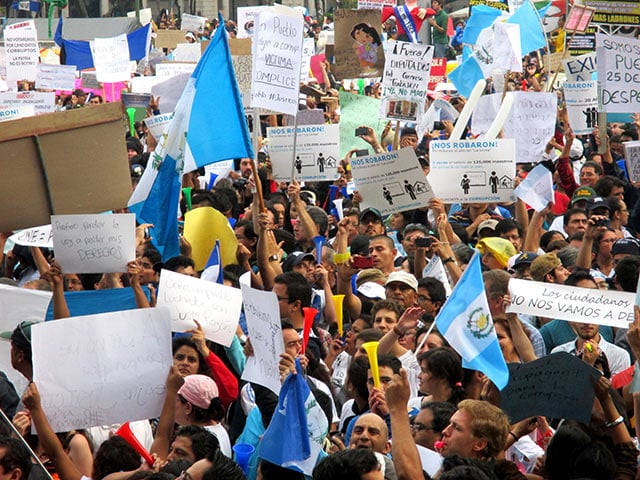
Guatemalans are clamoring for change, pouring into the capital city’s central plaza on a weekly basis. From massive national mobilizations down to local consultations, defending territories from extractive industries, people all over Guatemala are taking action to take their country back from transnational corporations and the political, business and military elite.
The historic protests at the national level stem from a groundswell of outrage and indignation over revelations of widespread corruption within the highest levels of government. Guatemala prosecutors and the UN International Commission against Impunity in Guatemala cracked down on two major corruption rings within the National Tax Office and the Guatemalan Social Security Institute in April and May. The heads of both institutions have been arrested, along with the president of the country’s central bank and dozens of others inside and outside the government.
An estimated 60,000 Guatemalans from all walks of life took to the streets in the capital on May 16, and thousands more participated in marches and rallies in the interior.
The revelations ignited a diverse, decentralized movement, and the Guatemalan government has been scrambling to put out the flames. A series of resignations of high-level officials is widely viewed as an attempt by President Otto Pérez Molina to appease protesters, while hanging onto power. The vice president; the secretary of strategic intelligence; the cabinet ministers of the interior, energy and mines, and the environment and natural resources; and other officials have all stepped down from their posts. The mobilizations continue to grow, however, and the people’s movement’s demands are increasingly shifting from the call for Pérez Molina’s resignation to a much more radical transformation of the state.
An estimated 60,000 Guatemalans from all walks of life took to the streets in the capital on May 16, and thousands more participated in marches and rallies in the interior. The following day, 65 miles south of Guatemala City, the mostly Indigenous Xinka population of San Juan Tecuaco voted on whether it would permit mining activities in its territory. The local referendum was the result of local grassroots action by communities that organized together to call for the initiative.
Thelma García Godoy put her ID away as she walked home from a voting station in the center of San Juan Tecuaco. Her finger was stained with purple ink to show that she had already participated in the municipal referendum on mining. More than 2,000 residents cast their ballots at 14 voting centers throughout the municipality.
“I hope the majority of people are voting no [to mining] because it would harm us in many ways,” García Godoy told Truthout, smiling.
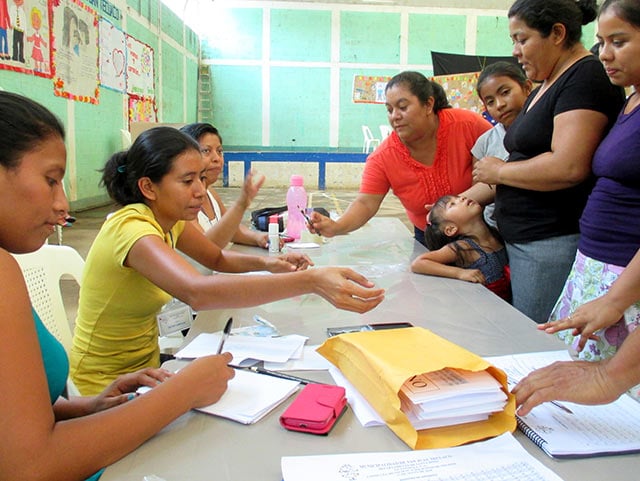 More than 98 percent of participating registered voters in San Juan Tecuaco voted against mining in the May 17 referendum. (Photo: Sandra Cuffe)
More than 98 percent of participating registered voters in San Juan Tecuaco voted against mining in the May 17 referendum. (Photo: Sandra Cuffe)
Protecting the community’s water supply was on García Godoy’s mind on referendum day. Water shortages have been increasing in recent years, she said, and there are neighborhoods in town that receive very little water or even none at all. “The water just isn’t enough anymore,” she said, concerned that any mining activity could diminish or pollute water in the area.
By the end of the day, it was clear that the people of San Juan Tecuaco don’t want mining in their territory. More than 98 percent of participating, registered voters in the May 17 referendum rejected mining in the municipality, home to 11,000 people. More than 2,600 of some 6,000 registered voters cast a ballot. There were three blank and 36 void ballots. Twenty-seven people cast a ballot in favor of mining, and 2,558 voted against it.
The grassroots-driven referendum in San Juan Tecuaco is part of a movement across the Western Hemisphere to exercise democratic control at the local level in an attempt to keep mining companies out. People in Tambogrande, Peru, and Esquel, Argentina, set important precedents in 2002 and 2003, respectively, by building powerful movements and forcing the local governments to back popular referendum initiatives on mining. Since then, examples have been popping up in South America, Central America and Mexico.
Further north, in the United States, local and regional initiatives to ban fracking can be seen as part of this decentralized hemispheric movement. They are both struggles for self-government, autonomy and control over lands at the local level, and struggles against extractive industries and corporate power. In the US, there are local bans on fracking in at least 24 states, and others in Indigenous territories.
People organized themselves and do not permit any machinery not authorized by the municipality to enter [municipal lands].
In Guatemala, there are no statewide decrees, such as New York State’s ban on fracking, as there is nothing analogous to state-level government. Guatemala’s departments – often compared to states – are merely administrative divisions, with appointed governors who wield little political power. Only municipal and national governments are elected, and there is only one legislature at the national level. Guatemalan communities actively resisting extractive industry projects often face violent backlash from public and corporate security forces. In the US, local bans on fracking, like the one in Denton, often face virulent political backlash from states such as Texas.
The legal implications of the initiatives in the South may not be as clear as some in the US, but no country in the hemisphere has been host to as many local referenda on extractive industries as Guatemala. Community-driven consultation processes have been held in more than 70 municipalities around the country, in which more than 1.5 million people have participated. By allowing municipal residents at the community level to express whether or not they want mining in their territory, the consultations raise awareness about mining and unite local populations.
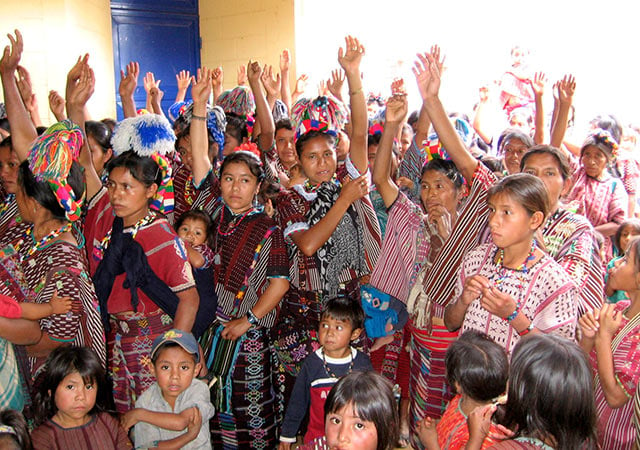 Mayan women raise their hands to vote against mining in a 2007 community consultation in the municipality of Colotenango, in the Huehuetenango department. (Photo: Sandra Cuffe)
Mayan women raise their hands to vote against mining in a 2007 community consultation in the municipality of Colotenango, in the Huehuetenango department. (Photo: Sandra Cuffe)
Most consultations in Guatemala have taken place in Indigenous areas, according to local customs. They have relied largely on the international legal framework established in the International Labor Organization’s Convention 169 on the Rights of Indigenous and Tribal Peoples in Independent Countries, ratified by Guatemala, and the United Nations Declaration on the Rights of Indigenous Peoples. Elsewhere, consultations have been based in municipal law and electoral procedure.
The referendum in San Juan Tecuaco encompassed elements of both kinds of consultations. Most local residents in the impoverished, mountainous municipality are Xinka, one of the two non-Mayan Indigenous peoples in Guatemala. The consultation was carried out in the same way others have occurred in the Santa Rosa and the neighboring department of Jalapa: using the municipal code as its legal framework and a standardized process similar to that used in local elections.
An incident roughly two years ago set the gears in motion for the May 17 referendum, according to Wiliam García, the mayor of San Juan Tecuaco.
“Residents informed us that people unknown to locals were bringing in suspicious machinery,” García told Truthout, in an interview in the town hall, where voters filed in to cast their ballots. “The suspicion was that it was for mining, not necessarily in our municipality, but in neighboring properties,” he said.
There is no mining license covering San Juan Tecuaco itself, but there are mining interests in the Santa Rosa department, including Tahoe Resources’ contentious Escobal silver mine. All lands in San Juan Tecuaco are municipal lands, so the local government is usually apprised of what’s going on in the territory. García traveled to Guatemala City to visit the Ministry of Energy and Mines, now embroiled in corruption scandals, to verify whether or not any mining project or license overlapped with San Juan Tecuaco lands.
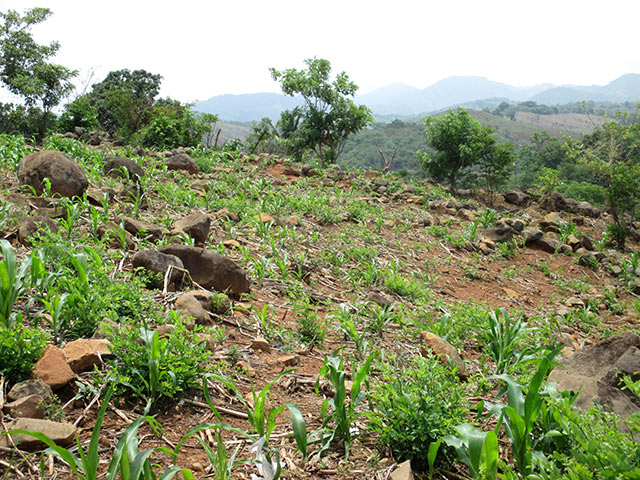 Agriculture is the main economic activity in San Juan Tecuaco, despite its rocky slopes. Residents grow corn, beans, sesame, rice and other crops. (Photo: Sandra Cuffe)
Agriculture is the main economic activity in San Juan Tecuaco, despite its rocky slopes. Residents grow corn, beans, sesame, rice and other crops. (Photo: Sandra Cuffe)
“The suspicion was that [San Juan Tecuaco] was going to fall along a transit route for mining machinery. In fact, to prevent all of this, people organized themselves and do not permit any machinery not authorized by the municipality to enter [municipal lands],” said García. In practice, this has entailed community residents blocking the road, physically preventing the machinery or equipment from advancing.
Meanwhile, residents came together to petition their local government for a referendum on mining. They presented the mayor with a formal request, setting the wheels in motion. A municipal decree was published in the country’s official gazette announcing the date and details of the event. “We’re just proceeding according to the people’s petition,” said García, adding that the municipal government was carrying out the consultation with the help of CODIDENA, the Diocesan Committee in Defense of Nature. “It’s a preventative measure, to seek peace in the municipality,” he said.
“Women participate more now and get involved, free of the confinement we experienced because we were denied participation.”
Many emerging movements in Guatemala increasingly recognize intersectionality, including an emphasis on women’s rights. Juventina Navarijo Asencia seemed to be everywhere on referendum day in San Juan Tecuaco. A member of the local Civil Society Association, she was busy trying to keep track of all of the national and international observers and other visitors in town for the event. Navarijo Asencia is also an active member of a local women’s group, the Tecuaquense Active Women’s Association. Its acronym, AMATE, also means “Love Yourself” in Spanish, and empowering women is a big part of the mandate of the group, in which 63 women are organized. Faced with very few local employment opportunities, they organize workshops for women on marketing local crafts, making homemade shampoo and soap and establishing vegetable gardens. With the help of a cooperative, they have facilitated micro-credit loans for local women, along with workshops on money management and participation in local affairs.
“In the past, the COCODEs [Community Development Councils] have been comprised only of men,” Navarijo Asencia told Truthout. The current municipal administration under García has been very supportive of women’s participation at the community and municipal level, she said. Women now make up 50 percent of the COCODE representatives in each community in the municipality, she said.
 Women were well represented at voting centers in the town of San Juan Tecuaco. Two of the four polling stations were staffed entirely by women, who were also the majority at the other two. (Photo: Sandra Cuffe)
Women were well represented at voting centers in the town of San Juan Tecuaco. Two of the four polling stations were staffed entirely by women, who were also the majority at the other two. (Photo: Sandra Cuffe)
Women were particularly engaged in the referendum on mining in the town of San Juan Tecuaco – in fact, the vast majority of people staffing the four polling stations in the Town Hall were women. “Women participate more now and get involved, free of the confinement we experienced because we were denied participation,” said Navarijo Asencia, adding that things really changed during García’s administration, beginning in 2012.
“We have to think of the children … If we don’t react now in our country to defend the good that we have in Guatemala, what are our kids going to find later? They’re going to find everything destroyed. Why? Because we didn’t do anything.”
On the day of the referendum, across the street from the Town Hall, Adán Cano González waited for his ride at the edge of San Juan Tecuaco’s central park. One of three dozen national observers from the municipality of Casillas, in the Santa Rosa department, Cano González was assigned to one of the more remote voting centers. People from the municipality of Mataquescuintla, in Jalapa, were also participating as observers in San Juan Tecuaco. Referendums on mining have already been held in both municipalities, and both are adjacent to the municipality of San Rafael Las Flores, home to Tahoe Resources’ Escobal silver mine. The anti-mining struggle has been a point of unity in the region, transcending geographic and political boundaries.
“We live close to the mining in San Rafael, so we are aware of the harms mining is causing,” Cano González told Truthout, while he waited for his ride. “Many people are against mining. [Mining companies] promise this, that and the other, but it’s all just tricks.”
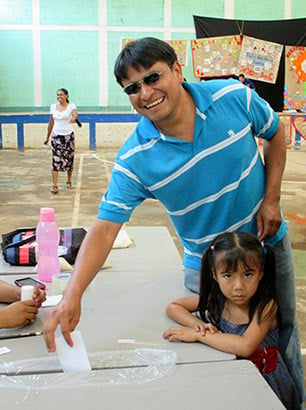 A voter casts his ballot at a polling station in San Juan Tecuaco’s town hall. (Photo: Sandra Cuffe)Ninety-eight percent of participating registered voters in Casillas rejected mining on August 7, 2011. The November 11, 2012, popular municipal referendum in Mataquescuintla had similar results. Both places have been affected beyond their proximity to the Tahoe Resources mine. After mine security personnel opened fire on community protesters in April 2013, provoking further conflict in the area, the Guatemalan government declared a state of siege in San Rafael Las Flores, Casillas and Mataquescuintla on May 2, 2013. The hotbeds of community resistance to mining were heavily militarized, and basic constitutional rights and protections such as freedom of assembly and detainee rights were suspended for a week.
A voter casts his ballot at a polling station in San Juan Tecuaco’s town hall. (Photo: Sandra Cuffe)Ninety-eight percent of participating registered voters in Casillas rejected mining on August 7, 2011. The November 11, 2012, popular municipal referendum in Mataquescuintla had similar results. Both places have been affected beyond their proximity to the Tahoe Resources mine. After mine security personnel opened fire on community protesters in April 2013, provoking further conflict in the area, the Guatemalan government declared a state of siege in San Rafael Las Flores, Casillas and Mataquescuintla on May 2, 2013. The hotbeds of community resistance to mining were heavily militarized, and basic constitutional rights and protections such as freedom of assembly and detainee rights were suspended for a week.
Nevertheless, Cano González has not been dissuaded from openly opposing mining. The coffee, corn and bean farmer came to San Juan Tecuaco to support the people’s right to decide what activities they want in their territory.
“We have to think of the children,” he said. “If we don’t react now in our country to defend the good that we have in Guatemala, what are our kids going to find later? They’re going to find everything destroyed. Why? Because we didn’t do anything.”
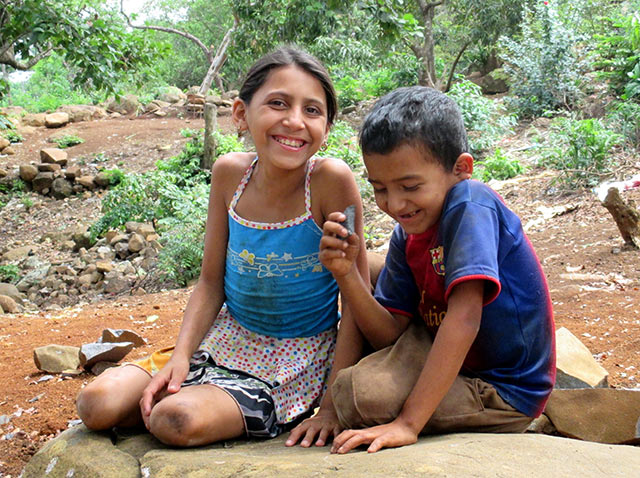 The Xinka are one of the two non-Mayan Indigenous peoples in Guatemala. (Photo: Sandra Cuffe)
The Xinka are one of the two non-Mayan Indigenous peoples in Guatemala. (Photo: Sandra Cuffe)
Communities around Guatemala stand by the results of their referendums and consultations on mining, fighting to uphold the results and keep their territories free of any and all extractive industry activities. They have also had to fight for legal recognition of the results. Mataquescuintla brought a case to the Constitutional Court of Guatemala to push for a ruling declaring the local referendum binding. The outcome was somewhat of a half win. The national government and ministry of energy and mines must consider the local referendum results, but the ruling stops short of ascribing veto power to the referenda results.
Moreover, community resistance to mining has been on the agenda at the recent anticorruption protests taking Guatemala by storm. Demands for President Otto Pérez Molina to resign continue, but they are just the tip of the iceberg. Longtime social movement organizations, newly radicalized sectors and diverse groups of people participating in protests for the first time are increasingly rising up against not just individual officials, but an entire system. The collective hope for the country’s transformation – from the grassroots on up – is palpable in the streets.
Join us in defending the truth before it’s too late
The future of independent journalism is uncertain, and the consequences of losing it are too grave to ignore. To ensure Truthout remains safe, strong, and free, we need to raise $27,000 in the next 24 hours. Every dollar raised goes directly toward the costs of producing news you can trust.
Please give what you can — because by supporting us with a tax-deductible donation, you’re not just preserving a source of news, you’re helping to safeguard what’s left of our democracy.